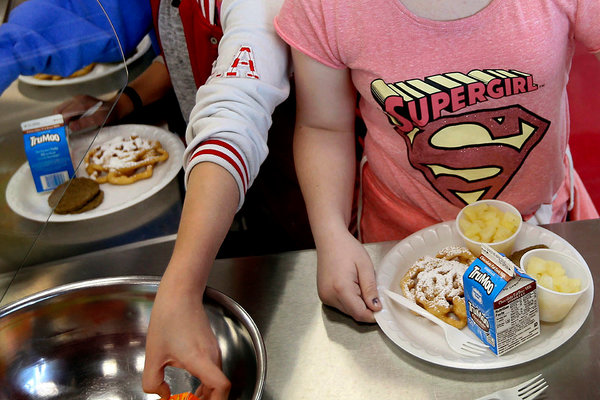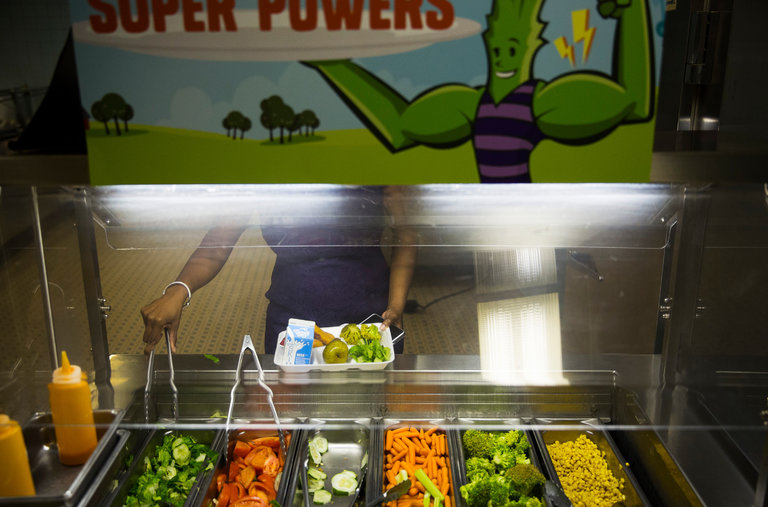Four years ago, Dan Giusti was arguably at the top of the cooking world. Born in New Jersey and trained at the Culinary Institute of America, he was the head chef at Noma, the Copenhagen restaurant that perennially lands on lists of the world’s best. On his watch, Noma received two Michelin stars and drew glowing reviews.
Today, Mr. Giusti is cooking for a much larger — and pickier — group of critics: thousands of students in the Bronx.
This detour emerged about three years into his time at Noma, when Mr. Giusti felt a growing need to make an impact on people’s lives rather than just an impression on their palates. He started researching how he could affect American students’ eating habits through the National School Lunch Program, which provides free or low-cost lunches to schoolchildren.
Mr. Giusti moved back to the United States, and in 2016 — riding the momentum created by Michelle Obama and education leaders who had already helped raise federal nutritional standards for schools — started a company called Brigaid. It aims to overhaul school meals by putting professional chefs in the cafeterias and replacing processed foods with wholesome cooking.

A now typical homemade lunch at five schools in the Bronx: Peruvian chicken, yellow rice, stewed beans, fresh cut cantaloupe and a salad.CreditJeenah Moon for The New York Times
The fruits of Mr. Giusti’s efforts are now on display at five of the 446 public schools in the Bronx, where Brigaid started cooking this school year for more than 2,400 students. Popcorn chicken, purchased in bags and reheated, is out; roasted bone-in chicken with Caribbean spices is in. Pizza is no longer frozen, but made fresh, starting with the dough.
“The kids are just excited about the fact that they have this different menu and this exciting scratch kitchen,” said Chris Tricarico, the acting executive director of food and nutrition services for the New York City schools, where Brigaid is the only outside company cooking from scratch.
The sensory experience of smelling chicken as it roasts and seeing meals being prepared has made an impression on many students. “In the morning, you see them cutting the fruit, and you know you’re going to eat fruit that’s fresh,” said Sonia Scarso, a senior at Bronx International High School.
Then there’s the taste. “Last year when I used to eat lunch it was, like, it tasted like prison food,” said Matthew Soto, a senior at Morris Academy for Collaborative Studies. This year, he said, “it looked like fresh out of the oven.”
But Brigaid’s arrival in the Bronx has also shown the limits of its good intentions. Although the company initially envisioned cooking in six sites this year, only two are up and running: a kitchen operation that started cooking last fall for four schools (including Bronx International and Morris Academy) that share a campus in the Morrisania neighborhood, and another that began in February at Public School/Intermediate School 218 in the Concourse section.
Finding qualified chefs has been a challenge, much to Mr. Giusti’s frustration. While many chefs tell Mr. Giusti they support his mission, working in a cafeteria doesn’t have the same cachet as in a restaurant. “They don’t think about it as a real chef job,” he said.
Making all that marinara sauce and meatloaf on site requires skilled labor. Ingredients need to be cleaned, cut and cooked, rather than just reheated, so the staff has to be trained in food handling and safety and, to varying degrees, knife and cooking skills. The kitchens must also be converted to scratch operations, with the right equipment and space to prevent any chance of cross-contamination.
Most worrisome is the number of students eating the meals: just 53 percent for the first half of this school year at the Morrisania campus, down from 66 percent for the same time last year, even though every New York City public school student is eligible for a free breakfast and lunch each day.
Mr. Giusti, 34, is unsurprised by the numbers. Both he and school officials point out that lunchtime routines at the four Morrisania schools have been disrupted: Before this year, students ate only in classrooms. Now, everyone eats in the cafeteria.
Before he even reached the Bronx, Mr. Giusti knew there would be hurdles: He had already taken over all the cooking for the nine public schools in New London, Conn., where Brigaid is now in its third year.
The company arrived in New London, a city of just over 27,000 residents — more than a third of them living below the poverty level and all 3,792 students receiving free lunches — to a mix of fanfare and skepticism.
Dishes like kale Caesar salad and homemade hummus with naan made a good story, but were warily received by many students and parents.
“Hummus was an offering that’s quite delicious, but a lot of the kids saw this plate of mush that was very unknown to them,” said Mirna Martinez, a three-term member and past president of the New London Board of Education.
For her, the drastic menu switch meant she was finally comfortable with having her two children eat school-made lunches. “It’s something comparable enough to what I’d give them at home,” she said. “Real food. Not full of preservatives.”
To make meals more accessible and attract more students — the number taking the lunches in the New London schools has held steady at 78 percent for two years — Brigaid now serves dishes like hummus less frequently, while reversing some unpopular decrees it made early on.
“I took peanut butter and jelly off the menu because at the time, I didn’t want to serve it,” Mr. Giusti said. “I thought it was a crutch. If the kids could eat that, they wouldn’t try anything else.” This year, a similar sandwich is on the menu every day — with sunflower butter instead of peanut butter.
Samantha Wilson, the schools’ director of food services, acknowledged that changing children’s tastes and habits would take time. “We have to recognize that the successes will come a little slower than perhaps what we’d like, but that’s O.K. because we’re changing their preferences.”
In the Bronx, one small victory has been getting students to eat fresh fruit; the apples that were previously doled out to meet the United States Department of Agriculture’s nutritional guidelines for schoolchildren — one daily serving of a fruit or vegetable — often wound up in the trash.
Now the staff dices up strawberries, watermelon, pineapple or other fruits every morning. Finding the extra money to buy them wasn’t easy. The federal government refunds schools a set amount per lunch: $3.44 in the Bronx and $3.33 in New London. After factoring in expenses for staff, equipment and transportation, the budget for food is $1.25 to $1.35, Mr. Giusti said.
“You’re spending an extra five cents” on the new fruits, he said, “but basically ensuring it’s going to be eaten.”
Since Brigaid is a for-profit business, balancing budgets is as essential as cooking skills. In addition to the $475,000 the company has raised in private investment, including a contribution from Noma’s founder, the chef René Redzepi, Brigaid charges the school districts annual consultancy fees: The $110,000 from New London and $295,000 from New York cover operating expenses, and salaries for the company’s six employees. Based on these numbers, Mr. Giusti said he expects Brigaid to break even by the end of the year.
In exchange for the fees, Brigaid helps recruit and train the chefs, who are employed by the schools. A Brigaid chef in each district oversees the school staff there, along with recipe development and adherence to food safety and sanitation standards.
Even as Brigaid finds its way in the Bronx, it is trying to scale up to more schools across the country by offering alternate models with varying levels of company involvement. One streamlined option is a 55-day training program that teaches schools how to set up their own kitchens, handle food safely and cook a select repertoire of scratch recipes that pass muster with the National School Lunch Program.
In support of the new model, Brigaid is also working with the nonprofit architecture firm MASS Design Group (Model of Architecture Serving Society) on a pilot study that assesses a school kitchen’s suitability for scratch cooking.
To train a new cadre of school cooks, Mr. Giusti wants to recruit chefs straight out of culinary school, not just from the restaurant and food-service businesses. “We could be creating the new leaders in this industry that doesn’t have any leaders,” he said. Schools could hire entry-level chefs who are committed to helping solve a national problem.
He shrugged off the Trump administration’s rollback of nutrition standards for whole grains, flavored milks and sodium in school cafeterias. “We’re not changing anything that we do internally,” he said.
In the Bronx, meanwhile, the future of Brigaid — and its contract for the next school year — are still being worked out.
“It’s great that we’re now in two sites and we’re learning more and more every day,” said Mr. Tricarico, of the New York school system, “but it’s important that we take a look at these sites and evaluate what’s going on, and look at how to continue to improve.”
Or as Mr. Giusti put it: “We’re still at the stage where we’re figuring out how to move things forward. Either way, something good has started.”








